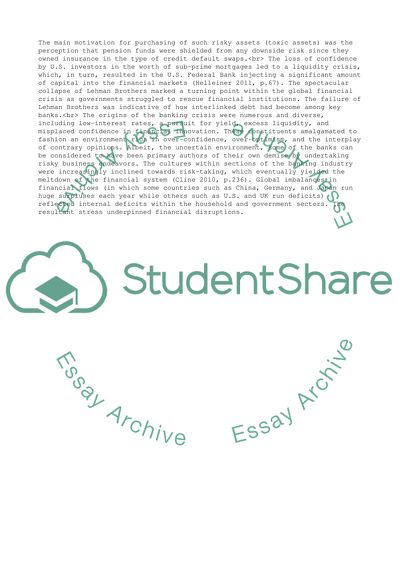Cite this document
(“In 2008 the Global Financial Crisis hit the world economy. Critically Assignment”, n.d.)
In 2008 the Global Financial Crisis hit the world economy. Critically Assignment. Retrieved from https://studentshare.org/business/1612667-in-2008-the-global-financial-crisis-hit-the-world-economy-critically-assess-the-strategic-factors-that-led-to-the-collapse-of-the-global-banking-industry-outline-a-strategy-for-ensuring-such-an-event-does-not-re-occur
In 2008 the Global Financial Crisis hit the world economy. Critically Assignment. Retrieved from https://studentshare.org/business/1612667-in-2008-the-global-financial-crisis-hit-the-world-economy-critically-assess-the-strategic-factors-that-led-to-the-collapse-of-the-global-banking-industry-outline-a-strategy-for-ensuring-such-an-event-does-not-re-occur
(In 2008 the Global Financial Crisis Hit the World Economy. Critically Assignment)
In 2008 the Global Financial Crisis Hit the World Economy. Critically Assignment. https://studentshare.org/business/1612667-in-2008-the-global-financial-crisis-hit-the-world-economy-critically-assess-the-strategic-factors-that-led-to-the-collapse-of-the-global-banking-industry-outline-a-strategy-for-ensuring-such-an-event-does-not-re-occur.
In 2008 the Global Financial Crisis Hit the World Economy. Critically Assignment. https://studentshare.org/business/1612667-in-2008-the-global-financial-crisis-hit-the-world-economy-critically-assess-the-strategic-factors-that-led-to-the-collapse-of-the-global-banking-industry-outline-a-strategy-for-ensuring-such-an-event-does-not-re-occur.
“In 2008 the Global Financial Crisis Hit the World Economy. Critically Assignment”, n.d. https://studentshare.org/business/1612667-in-2008-the-global-financial-crisis-hit-the-world-economy-critically-assess-the-strategic-factors-that-led-to-the-collapse-of-the-global-banking-industry-outline-a-strategy-for-ensuring-such-an-event-does-not-re-occur.


